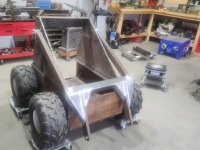Hi Guys! My name is Jon, this is my first time posting on here. For the last couple of months I have been working on my chassis and loader for my little homeade wheeled mini skid project. Its coming along pretty good, and now its time to start ordering hydraulic components. This is where I am hoping I can get some assistance from some of you who know way more than I do about these calculations. So what I have to power this thing is a 24 hp honda vtwin. I picked this because 24 to 25 hp seems to be pretty standard on the mini skid market for machines about this size. Thats all ive got so far is the engine, I now need to order a gear pump, 2 wheel motors, lift and tilt cylinders, hoses, valves, all kinds of stuff. My machine is going to work the same way most skidsteers work, or at least used to work. One hydraulic motor on each side will chain drive the tires on that side via sprockets.
I hope to achieve good torque as well as ground speed with the pump, hydraulic motor, sprocket combo I go with. From what I have seen online looking at these things, around 5 mph ground speed seems to be what to shoot for. Overall, I believe the machine is built heavy enough to be stable picking up somewhere between 600 to 1000lbs. Anywhere in there would be cool. Aside from that, If I could achieve somewhere around 11-13 gpm auxillary flow for attachements that would be awesome. So for anyone who knows or is willing to help, here are my main questions
1: I plan to use a triple stack gear pump, mainly just because everyone else is so im assuming that's the way to go. One pump for each drive motor, and one for boom and auxiliary hydraulics. Given what I hope to achieve with the machine, how would you go about sizing each pump?
2: Same goes for wheels motors. I believe the older wheeled dingos used about 30cc per rev wheel motors. Guessing ill need somewhere around there? But id hate to spend big money on motors and find out they won't work for me
3: Sprocket size. I have designed my hubs in a way where I change sprockets out If I don't like it, But a general idea of how many tooth sprockets to achieve the max power while still achieving the desired ground speed is needed.
4: hydraulic tank size? From what I've read I think its important to have extra fluid available so that It gets a chance to cool down before being recirculated again. An idea of how many gallons I should design my tank to hold would be great.
5: General hydraulic question. What all can I expect to get out of my 24hp engine hydraulic wise? Like If I wanted to shoot for even higher than 11-13 gpm aux flow, is this possible with this size engine? Or would doing so limit my ability to do anything else, like drive? I would imagine 11-13 gpm is fine, but hey if i can get more I dont want to limit myself. Not that I really expect to be able to run a brush cutter with this thing, but if I can someday then cool.
To whomever chimes in, I greatly appreciate it!!!!
I hope to achieve good torque as well as ground speed with the pump, hydraulic motor, sprocket combo I go with. From what I have seen online looking at these things, around 5 mph ground speed seems to be what to shoot for. Overall, I believe the machine is built heavy enough to be stable picking up somewhere between 600 to 1000lbs. Anywhere in there would be cool. Aside from that, If I could achieve somewhere around 11-13 gpm auxillary flow for attachements that would be awesome. So for anyone who knows or is willing to help, here are my main questions
1: I plan to use a triple stack gear pump, mainly just because everyone else is so im assuming that's the way to go. One pump for each drive motor, and one for boom and auxiliary hydraulics. Given what I hope to achieve with the machine, how would you go about sizing each pump?
2: Same goes for wheels motors. I believe the older wheeled dingos used about 30cc per rev wheel motors. Guessing ill need somewhere around there? But id hate to spend big money on motors and find out they won't work for me
3: Sprocket size. I have designed my hubs in a way where I change sprockets out If I don't like it, But a general idea of how many tooth sprockets to achieve the max power while still achieving the desired ground speed is needed.
4: hydraulic tank size? From what I've read I think its important to have extra fluid available so that It gets a chance to cool down before being recirculated again. An idea of how many gallons I should design my tank to hold would be great.
5: General hydraulic question. What all can I expect to get out of my 24hp engine hydraulic wise? Like If I wanted to shoot for even higher than 11-13 gpm aux flow, is this possible with this size engine? Or would doing so limit my ability to do anything else, like drive? I would imagine 11-13 gpm is fine, but hey if i can get more I dont want to limit myself. Not that I really expect to be able to run a brush cutter with this thing, but if I can someday then cool.
To whomever chimes in, I greatly appreciate it!!!!

